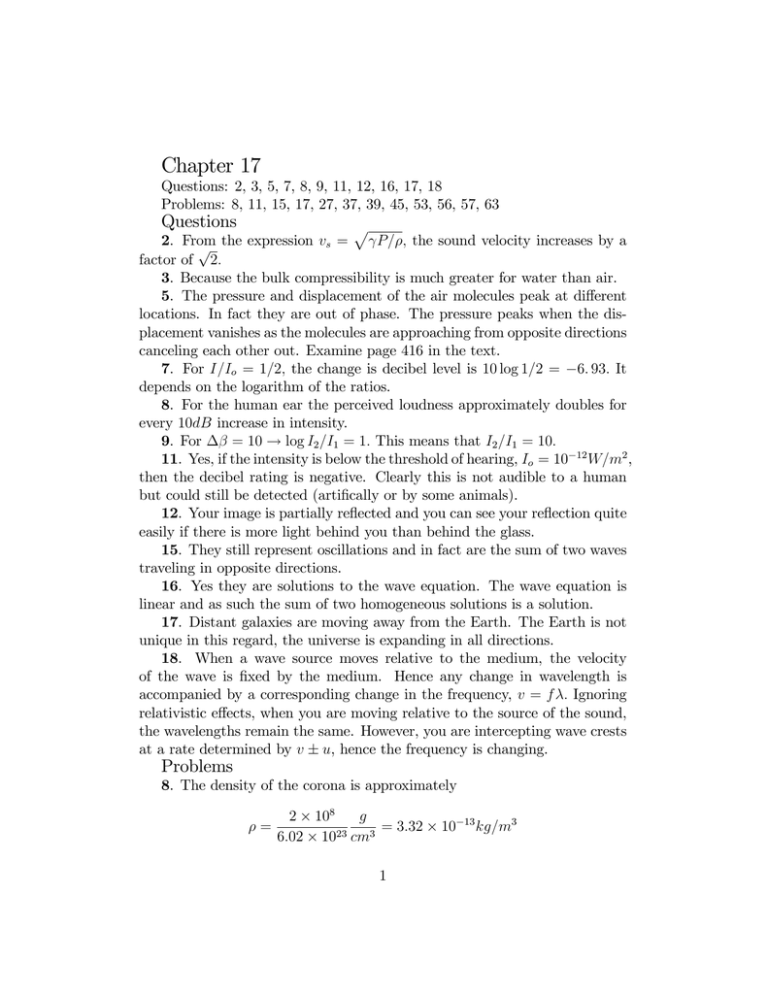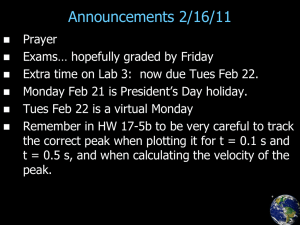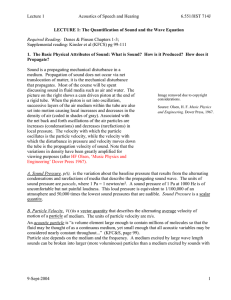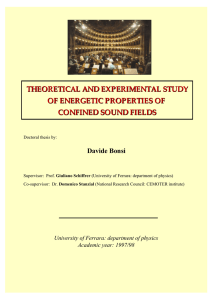Chapter 17
advertisement

Chapter 17 Questions: 2, 3, 5, 7, 8, 9, 11, 12, 16, 17, 18 Problems: 8, 11, 15, 17, 27, 37, 39, 45, 53, 56, 57, 63 Questions p P= ; the sound velocity increases by a 2. From the expression v = s p factor of 2: 3. Because the bulk compressibility is much greater for water than air. 5. The pressure and displacement of the air molecules peak at di¤erent locations. In fact they are out of phase. The pressure peaks when the displacement vanishes as the molecules are approaching from opposite directions canceling each other out. Examine page 416 in the text. 7. For I=Io = 1=2; the change is decibel level is 10 log 1=2 = 6: 93: It depends on the logarithm of the ratios. 8. For the human ear the perceived loudness approximately doubles for every 10dB increase in intensity. 9. For = 10 ! log I2 =I1 = 1: This means that I2 =I1 = 10: 11. Yes, if the intensity is below the threshold of hearing, Io = 10 12 W=m2 , then the decibel rating is negative. Clearly this is not audible to a human but could still be detected (arti…cally or by some animals). 12. Your image is partially re‡ected and you can see your re‡ection quite easily if there is more light behind you than behind the glass. 15. They still represent oscillations and in fact are the sum of two waves traveling in opposite directions. 16. Yes they are solutions to the wave equation. The wave equation is linear and as such the sum of two homogeneous solutions is a solution. 17. Distant galaxies are moving away from the Earth. The Earth is not unique in this regard, the universe is expanding in all directions. 18. When a wave source moves relative to the medium, the velocity of the wave is …xed by the medium. Hence any change in wavelength is accompanied by a corresponding change in the frequency, v = f : Ignoring relativistic e¤ects, when you are moving relative to the source of the sound, the wavelengths remain the same. However, you are intercepting wave crests at a rate determined by v u, hence the frequency is changing. Problems 8. The density of the corona is approximately = g 2 108 = 3:32 23 6:02 10 cm3 1 10 13 kg=m3 Hence the sound speed in the corona is appoximately s r P 5 3 10 3 vs = = = 1:23 105 m=s = 123km=s 3 3:32 10 13 11. The molar density on Titan is 1/3 of that on the Earth at STP. Hence 1 1 n = = 14:88mol=m3 : V T itan 3 22:4 10 3 This atmosphere is 100% nitrogen with a molecular weight of 28. Hence the mass density is = 14:88 :028 = :417kg=m3 The atomspheric pressure on Titan is 50% greater than Earth’s or PT itan = 1:5 105 P a: The sound speed at the surface of Titan is r p 7 1:5 105 = 710m=s P= = vs = 5 :417 15. For an average sound intensity of I = 1 W=m2 at a frequency of 2:5kHz, we have 1 I = ! 2 vs2o ; 2 so that 2I : s2o = !2v In air v ' 343m/s, and ' 1:2kg=m3 : Also ! = 2 f = 1:57 104 rad=s. Substituting with these values we …nd 2 10 6 = 1:97 1:2 (1:57 104 )2 343 = 4:44 10 9 m = 4:44nm. s2o = so 10 17 m2 ; 17. (a) The average intensity of 1:2W sound at 5m is I= 1:2 P = = 3:82 2 4 r 100 10 3 W=m2 = 3:82mW=m2 (b) The decibel level is = 10 log I=10 = 95:8dB 12 = 10 log 3:82 2 109 = 90 + 10 log 3:82 (c) The pressure amplitude is found from I= P2 ! v 1 2 P = p 2I v = p 2 3:82 10 3 1:2 343 = 1:77P a (d) The displacement amplitude is found from p 1 v (!so )2 ! !so = 2I= v 2 1 p 1 p = 2I= v = 2 3:82 2 f 880 = 1:56 10 6 m = 1:56 m I = so so 10 3 = (1:2 343) 27. The intensity ratio’s are 75 65 = 10 log (I2m =Ix ) ! I2m =Ix = 10 Since p the intensity falls o¤ as 1=r2 the distance for the 10db reduction is x = 2 10 = 6:32m: 37. For the bulk sound velocity, vB ; to equal the velocity of a transverse wave along a wire, vT , of the same material we must satisfy vB2 = B= = vT2 = T = = T = T = B r2 : r2 ; or For :5mm diameter steel wire with a bulk modulus of B = 1:6 the required tension is T = 1:6 1011 4 5 10 4 2 = 3:14 1011 N=m2 ; 104 N = 31:4kN . The maximum tensile force for this geometry in steel before it deforms is T = 50N . Hence the steel deforms before the velocity of a transverse wave is equal to the sound velocity. 39. (a) For a string clamped at both ends the boundary condition for standing waves derives from the condition sin kL = 0: This requires kL = m or 2 L = m =2 or 3 L=m ; = 2L=m: :The second harmoic has a wavelength 1=2 of the fundamental frequency, f1 = 140Hz. Therefore it has twice the frequency or f2 = 2f1 = 280Hz. (b) For the same string condition, except one end is free, the boundary condition for standing waves derives from the condition sin kL = 1: This requires kL = =2 + m or 2 L = =2 + m ; L = (2m + 1) =4; or = 4L= (2m + 1) : The fundamental mode satis…es = 4L which is twice the wavelength of the fundamental mode for a pinned string. Hence the frequency is 1=2 of 140 Hz, or f1 = 70Hz: (c) The next highest frequency is determined by = 4L=3;so that the frequency is 3 times the fundamental mode. Thus f3 = 210Hz. 45. For the fundamental mode a clamped string satis…es = 2L. (a) For L = 30cm the fundamental frequency is 197Hz. Increasing this frequency to 440Hz requires L= 197 30 = 13:4cm 440 from the bridge. This is 30 13:4 = 16:6cm from the end. (b) When L = 13:4 + :5cm = 13:9cm, the fundamental frequency is given by 30 197 = 425Hz, f= 13:9 and when L = 13:4 :5cm = 12:9cm, the fundamental frequency is given by f= 30 197 = 458Hz. 12:9 53. For an approaching source with a velocity u the Doppler shift in air is f 0 = f = (1 u=v) : For f = 380Hz, u = 17m=s, and v = 343m=s the apparent frequency is f 0 = 380=:95 = 400Hz. 4 55. The Doppler shift for an approaching source is given by f0 1 = ; f 1 u=v f u = v 1 f0 : Given that f =f 0 = 1400=1600 = 7=8 we have u = 343=8 = 43m=s = 154km=hr = 96mi=hr. 56. The Doppler shift for light from a receding object is s 1 + v=c 0 = 1 v=c Hence the relative velocity of the galaxy is 2 0 2 ( = ) (1 v=c) = 1 + v=c ! v=c = ( 0= ) 0 1 2 ( = ) +1 2 v=c = Since c = 3 (708=656) 1 = :076 2 (708=656) + 1 108 m=s the velocity is 107 m=s v = 2:28 63. From measurements we …nd tan sin = 13=17 = :765 ! = tan 1 :765 = :65rad: = :6 ! u=v = 1= sin = 1:65; or u = M ach1:65. 5







